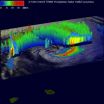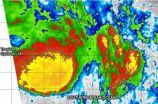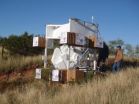(Press-News.org) When people see a skunk, the reaction usually is "Eww," but when they see a group of meerkats peering around, they often think "Aww."
Why some animals use noxious scents while others live in social groups to defend themselves against predators is the question that biologists Tim Caro of the University of California, Davis and Theodore Stankowich of California State University, Long Beach and sought to answer through a comprehensive analysis of predator-prey interactions among carnivorous mammals and birds of prey.
Their findings appear in the online edition of the journal Evolution.
"The idea is that we're trying to explain why certain antipredator traits evolved in some species but not others," said Stankowich, who noted that this study not only explains why skunks are stinky and why banded mongooses live in groups but also breaks new ground in the methodology of estimating predation risks.
Caro, Stankowich and Paul Haverkamp, a geographer who recently completed his Ph.D. at UC Davis, collected data on 181 species of carnivores, a group in which many species are small and under threat from other animals. They ran a comparison of every possible predator-prey combination, correcting for a variety of natural history factors, to create a potential risk value that estimates the strength of natural selection due to predation from birds and other mammals.
They found that noxious spraying was favored by animals that were nocturnal and mostly at risk from other animals, while sociality was favored by animals that were active during the day and potentially vulnerable to birds of prey.
"Spraying is a good close-range defense in case you get surprised by a predator, so at night when you can't detect things far away, you might be more likely to stumble upon a predator," Stankowich said.
Conversely, small carnivores like mongooses and meerkats usually are active during the day which puts them at risk from birds of prey. Living in a large social group means "more eyes on the sky" in daytime, when threats can be detected further away.
The social animals also use other defenses such as calling out a warning to other members of their group or even mobbing together to bite and scratch an intruder to drive it away.
The project was a major information technology undertaking involving plotting the geographic range overlap of hundreds of mammal and bird species, but will have long-term benefits for ongoing studies. The researchers plan to make their database, nicknamed the "Geography of Fear," available to other researchers.
INFORMATION:
Additional media contact: Anne Ambrose, CSU Long Beach, (562) 985-2582, anne.ambrose@csulb.edu
Social or stinky? New study reveals how animal defenses evolve
2014-02-08
ELSE PRESS RELEASES FROM THIS DATE:
Endocrine Society calls for large-scale studies to evaluate testosterone therapy risks
2014-02-08
Chevy Chase, MD—According to a statement issued today by the Endocrine Society, the risks and benefits of testosterone therapy for older men with declining levels of the hormone need to be fully evaluated.
The statement comes in response to recent studies that have raised concerns about the safety of testosterone therapy in older men with a history of heart disease. Two retrospective analyses and one randomized trial supported by the Veterans Health Care System, and the National Institutes of Health found a higher rate of cardiovascular events in men who received testosterone ...
NASA spots very heavy rainfall rates in Tropical Cyclone Edilson
2014-02-08
Imagine receiving as much as 7 inches of rain in one hour. That's about what NASA's TRMM satellite spotted falling in one area within Tropical Cyclone Edilson as it moved over the Southern Indian Ocean.
The Tropical Rainfall Measuring Mission or TRMM satellite is managed by both NASA and the Japan Aerospace Exploration Agency called JAXA. TRMM can read the rate in which rain is falling on Earth while in its orbit high above.
The TRMM satellite had an excellent early morning look at Edilson on February 7, 2014 at 0237 UTC/06:28 local time when it passed directly above ...
Diaphragm pacing in spinal cord injury successful in weaning patients from ventilators
2014-02-08
CLEVELAND – A new study published in the Journal of Trauma and Acute Care Surgery finds that diaphragm pacing (DP) stimulation in spinal cord-injured patients is successful not only in weaning patients from mechanical ventilators but also in bridging patients to independent respiration, where they could breathe on their own without the aid of a ventilator or stimulation.
The stimulation is provided by the Diaphragm Pacing System (DPS), a technology providing electrical stimulation to nerves running through the diaphragm, the major muscle involved in breathing. When stimulated, ...
NASA spots fourteenth tropical cyclone of Southern Indian Ocean season
2014-02-08
The fourteenth tropical cyclone of the Southern Indian Ocean season was born as NASA's Terra satellite passed overhead.
On February 7 at 0900 UTC/4 a.m. EST, Tropical Cyclone 14S had maximum sustained winds near 35 knots/40 mph/62 kph. It was located about 814 nautical miles/936.7 miles/1,508 km east-northeast of Port Louis, Mauritius near 14.8 south and 70.4 east. At that time, 14S was moving to the south near 8 knots/9.2 mph/14.8 kph.
The Joint Typhoon Warning Center noted that multispectral satellite imagery showed that the low-level center is exposed to outside ...
Thinking skills take biggest hit from anxiety in midlife women with HIV
2014-02-08
CLEVELAND, Ohio (Friday, February 7, 2014)—Hot flashes, depression, and most of all, anxiety, affect the thinking skills of midlife women with HIV, so screening for and treating their anxiety may be especially important in helping them function, according to a study just published online in Menopause, the journal of The North American Menopause Society (NAMS). The reproductive stage, whether it was premenopause, perimenopause or postmenopause, did not seem to be related to these women's thinking skills.
The conclusions come from a new analysis of data on 708 HIV-infected ...
WASP gives NASA's planetary scientists new observation platform
2014-02-08
Scientists who study Earth, the sun and stars have long used high-altitude scientific balloons to carry their telescopes far into the stratosphere for a better view of their targets. Not so much for planetary scientists. That's because they needed a highly stable, off-the-shelf-type system that could accurately point their instruments and then track planetary targets as they moved in the solar system.
That device now exists.
NASA's Wallops Flight Facility in Wallops Island, Va., has designed a new pointing system — the Wallops Arc Second Pointer (WASP) — that can point ...
Study provides surprising new clue to the roots of hunger
2014-02-07
BOSTON – While the function of eating is to nourish the body, this is not what actually compels us to seek out food. Instead, it is hunger, with its stomach-growling sensations and gnawing pangs that propels us to the refrigerator – or the deli or the vending machine. Although hunger is essential for survival, abnormal hunger can lead to obesity and eating disorders, widespread problems now reaching near-epidemic proportions around the world.
Over the past 20 years, Beth Israel Deaconess Medical Center (BIDMC) neuroendocrinologist Bradford Lowell, MD, PhD, has been untangling ...
New method developed for ranking disease-causal mutations within whole genome sequences
2014-02-07
Seattle, Wash. and Huntsville, Ala.—Researchers from the University of Washington and the HudsonAlpha Institute for Biotechnology have developed a new method for organizing and prioritizing genetic data. The Combined Annotation–Dependent Depletion, or CADD, method will assist scientists in their search for disease-causing mutation events in human genomes.
The new method is the subject of a paper titled "A general framework for estimating the relative pathogenicity of human genetic variants," published in Nature Genetics.
Current methods of organizing human genetic variation ...
Study identifies protein to repair damaged brain tissue in MS
2014-02-07
Vittorio Gallo, PhD, Director of the Center for Neuroscience Research at Children's National Health System, and other researchers have found a "potentially novel therapeutic target" to reduce the rate of deterioration and to promote growth of brain cells damaged by multiple sclerosis (MS). Current therapies can be effective in patients with relapsing MS, but have little impact in promoting tissue growth.
The brain produces new cells to repair the damage from MS years after symptoms appear. However, in most cases the cells are unable to complete the repair, as unknown ...
Analysis of calls to IBD clinic predicts emergency visits and hospitalizations, Pitt finds
2014-02-07
PITTSBURGH, Feb. 7, 2014 – A comprehensive analysis of patient telephone records at an inflammatory bowel disease (IBD) clinic revealed that 15 percent of patients account for half of all calls to the clinic. Forty-two percent of frequent-caller patients also were seen in the emergency department or hospitalized within the following year.
The results, which can help doctors identify patients with the most severe disease and those at risk of potentially avoidable high-cost medical interventions, were reported in a study published online this week in the journal Clinical ...



